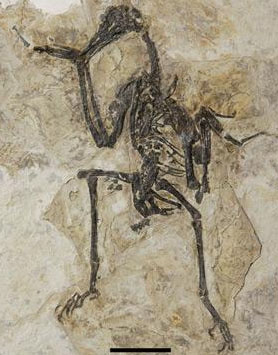| Location: Home > Research > Research Progress |
| A new Lower Cretaceous bird from China and tooth reduction in early avian evolution |
|
Dr. Zhonghe Zhou, Institute of Vertebrate Paleontology and Paleoanthropology, Chinese Academy of Sciences, and his colleagues, recently described a new avian genus and species, Zhongjianornis yangi gen. et sp. nov., a nearly complete and articulated skeleton, from the Lower Cretaceous lacustrine deposits of the Jiufotang Formation in Liaoning, northeast China. The new discovery adds to our understanding of avian biodiversity in the Early Cretaceous. Holotype of Zhongjianornis yangi gen. et sp. nov. (IVPP V15900). Scale bar, 5 cm. The new bird displays a combination of features that are unknown in any previously reported taxon; in particular, it represents the most basal avian that had completely lost teeth. It is characterized by possessing the following combination of features: upper and lower jaws toothless, snout pointed, humerus with large and robust deltopectoral crest, second phalanx of the major manual digit longer than the first phalanx, unguals of the alular and major digits of similar length and significantly shorter than the corresponding penultimate phalanges, tibiotarsus slender and more than twice the length of the tarsometatarsus, and metatarsal IV longer than the other metatarsals. Phylogenetic analysis indicates that Zhongjianornis is phylogenetically basal to Confuciusornis and the dominant Mesozoic avian groups, Enantiornithes and Ornithurae, and therefore provides significant new information regarding the diversification of birds in the Early Cretaceous. It also represents the most basal bird that completely lacks teeth, suggesting that tooth loss was more common than expected in early avian evolution and that the avian beak appeared independently in several avian lineages, most probably as a response to selective pressure for weight reduction. Finally, the presence of a significantly enlarged humeral deltopectoral crest suggests that Zhongjianornis shares with other basal birds such as Jeholornis, Sapeornis and Confuciusornis a distinctive mode of adaptation for flight contrasting with that seen in more advanced birds, which instead possess an elongated sternum and a prominent keel. The original paper is published in Proc. R. Soc. B (2010) 277, 219–227. |
